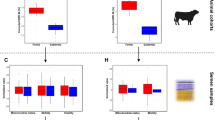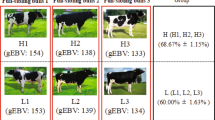Abstract
Composition of sperm biomolecules and their function in domestic animals has not been detailed yet. Unlike somatic cells, sperm contains low quantity of biologically degraded RNAs, extraction and profiling of total RNA from sperm become challenging to the reproductive biologists. Sperm RNAs are extracted using cocktail of lysis solution and successfully profiled employing various RNA sequencing platforms. Bioinformatic pipeline has been standardized for the analysis of sperm transcriptome data. Emerging evidences suggest that sperm RNAs can be of potential markers to assess the spermatogenic events and success of the fertilization process. Sperm RNAs are also potential candidates to predict successful embryonic development, pregnancy maintenance as well as the health and well-being of the offspring. In human sperm, RNA elements are reported to have diagnostic ability in predicting the success of assisted reproductive technologies. Thus, sperm RNA profiling can be a non-invasive method for predicting fertility of bulls. In future, this may become an initial step for screening bulls for breeding program.
Access this chapter
Tax calculation will be finalised at checkout
Purchases are for personal use only
Similar content being viewed by others
References
Amaral A, Castillo J, Ramalho-Santos J, Oliva R (2016) The combined human sperm proteome: cellular pathways and implications for basic and clinical science. Hum Reprod Update 20:40–62
Arangasamy VR, Kasimanickam JM, DeJarnette RK, Kasimanickam R (2011) Association of CRISP2, CCT8, PEBP1 mRNA abundance in sperm and sire conception rate in Holstein bulls. Theriogenology 76:570–577
Binsila BK, Selvaraju S, Somashekar L, Archana SS, Arangasamy A, Ravindra JP, Bhatta R (2017) Molecular advances in semen quality assessment and improving fertility in bulls-a review. Indian J Anim Reprod 39:1–10
Bissonnette N, Lévesque-Sergerie JP, Thibault C, Boissonneault G (2009) Spermatozoal transcriptome profiling for bull sperm motility: a potential tool to evaluate semen quality. Reproduction 138(1):65–80
Boerke A, Dieleman SJ, Gadella BM (2007) A possible role for sperm RNA in early embryo development. Theriogenology 68:147–155
Bosch P, Forcato D, Alustiza F et al (2015) Exogenous enzymes upgrade transgenesis and genetic engineering of farm animals. Cell Mol Life Sci 72:1907–1929
Bourchis D, Voinnet O (2010) A small-RNA perspective on gametogenesis, fertilization and early zygotic development. Science 330:617–622
Bukowska D, Kempisty B, Piotrowska H et al (2013) The structure and role of mammalian sperm RNA: a review. Vet Med 58:57–64
Cappallo-Obermann H, Schulze W, Jastrow H et al (2011) Highly purified spermatozoal RNA obtained by a novel method indicates an unusual 28S/18S rRNA ratio and suggests impaired ribosome assembly. Mol Hum Reprod 17:669–678
Giordano R, Magnano AR, Zaccagnini G et al (2000) Reverse transcriptase activity in mature spermatozoa of mouse. J Cell Biol 148:1107–1113
Goodrich R, Johnson G, Krawetz SA (2007) The preparation of human spermatozoal RNA for clinical analysis. Arch Androl 53:161–167
Guo F, Yang B, Ju ZH et al (2013) Alternative splicing, promoter methylation, and functional SNPs of sperm flagella 2 gene in testis and mature spermatozoa of Holstein bulls. Reproduction 147:241–252
Jodar M (2019) Sperm and seminal plasma RNAs: what roles do they play beyond fertilization? Reproduction 158:R113–R123
Jodar M, Selvaraju S, Sendler E, Diamond MP, Krawetz SA (2013) The presence, role and clinical use of spermatozoal RNAs. Hum Reprod Update 19:604–624
Jodar M, Sendler E, Moskovtsev SI et al (2015) Absence of sperm RNA elements correlates with idiopathic male infertility. Sci Transl Med 7:295
Johnson GD, Lalancette C, Linnemann AK et al (2011a) The sperm nucleus: chromatin, RNA, and the nuclear matrix. Reproduction 141:21–36
Johnson GD, Sendler E, Lalancette C et al (2011b) Cleavage of rRNA ensures translational cessation in sperm at fertilization. Mol Hum Reprod 17:721–726
Jones LJ, Yue ST, Cheung CY, Singer VL (1998) RNA quantitation by fluorescence-based solution assay: RiboGreen reagent characterization. Anal Biochem 265:368–374
Krawetz SA, Kruger A, Lalancette C et al (2011) A survey of small RNAs in human sperm. Hum Reprod 26:3401–3412
Lalancette C, Thibault C, Bachand I et al (2008) Transcriptome analysis of bull semen with extreme nonreturn rate: use of suppression-subtractive hybridization to identify functional markers for fertility. Biol Reprod 78:618–635
Liu WM, Pang RT, Chiu PC et al (2012) Sperm-borne microRNA-34c is required for the first cleavage division in mouse. Proc Natl Acad Sci U S A 109:490–494
Luk AC, Chan WY, Rennert OM, Lee TL (2015) Long noncoding RNAs in spermatogenesis: insights from recent high-throughput transcriptome studies. Reproduction 147:R131–R141
Mao S, Goodrich RJ, Hauser R et al (2013) Evaluation of the effectiveness of semen storage and sperm purification methods for spermatozoa transcript profiling. Syst Biol Reprod Med 59:287–295
Miller D (2015) Confrontation, consolidation, and recognition: the Oocyte's perspective on the incoming sperm. Cold Spring Harb Perspect Med 5:023408
Ni MJ, Hu ZH et al (2011) Identification and characterization of a novel non-coding RNA involved in sperm maturation. PLoS One 6(10):e26053
Okunade GW, Miller ML, Pyne GJ et al (2004) Targeted ablation of plasma membrane Ca2+-ATPase (PMCA) 1 and 4 indicates a major housekeeping function for PMCA1 and a critical role in hyperactivated sperm motility and male fertility for PMCA4. J Biol Chem 279:33742–33750
Ostermeier GC, Miller D, Huntriss JD et al (2004) Delivering spermatozoan RNA to the oocyte. Nature 429:154–154
Parthipan S, Selvaraju S, Somashekar L et al (2015) Spermatozoa input concentrations and RNA isolation methods on RNA yield and quality in bull (Bos taurus). Anal Biochem 482:32–39
Parthipan S, Selvaraju S, Somashekar L et al (2017) Spermatozoal transcripts expression levels are predictive of semen quality and conception rate in bulls (Bos taurus). Theriogenology 98:41–49
Ramya L, Swathi D, Archana SS, Lavanya M, Parthipan S, Selvaraju S (2021) Establishment of bioinformatics pipeline for deciphering the biological complexities of fragmented sperm transcriptome. Anal Biochem 620:114141
Rando OJ (2012) Daddy issues: paternal effects on phenotype. Cell 151:702–708
Rassoulzadegan M, Grandjean V, Gounon P et al (2006) RNA-mediated non-mendelian inheritance of an epigenetic change in the mouse. Nature 441:469–474
Saito T, Wada I, Inoue N (2019) Alternative splicing of the Izumo1 gene ensures triggering gamete fusion in mice. Sci Rep 9:1–9
Savadi-Shiraz E, Edalatkhah H, Talebi S et al (2014) Quantification of sperm specific mRNA transcripts (PRM1, PRM2, and TNP2) in teratozoospermia and normozoospermia: new correlations between mRNA content and morphology of sperm. Mol Reprod Dev 82:26–35
Sciamanna I, Spadafora C (2012) In: Smith KR (ed) Models of transgene integration and transmission. Sperm-mediated gene transfer: concepts and controversies. Bentham Science Publishers, New York, pp 117–124
Sciamanna I, Barberi L, Martire A et al (2003) Sperm endogenous reverse transcriptase as mediator of new genetic information. Biochem Biophys Res Commun 312:1039–1046
Sciamanna I, Vitullo P, Curatolo A et al (2009) Retrotransposons, reverse transcriptase and the genesis of new genetic information. Gene 448:180–186
Selvaraju S, Goodrich R, Diamond MP, Krawetz SA (2013) Quantification of miR34c-5p in human spermatozoa for predicting fertile semen sample. In 3rd annual CS Mott center scientific retreat, Detroit, Michigan
Selvaraju S, Parthipan S, Somashekar L et al (2017) Occurrence and functional significance of the transcriptome in bovine (Bos taurus) spermatozoa. Sci Rep 7:1–14
Selvaraju S, Parthipan S, Somashekar L et al (2018) Current status of sperm functional genomics and its diagnostic potential of fertility in bovine (Bos taurus). Syst Biol Reprod Med 64:484–501
Selvaraju S, Ramya L, Parthipan S, Swathi D, Binsila BK, Kolte AP (2021) Deciphering the complexity of sperm transcriptome reveals genes governing functional membrane and acrosome integrities potentially influence fertility. Cell Tissue Res 385:207–222
Sendler E, Johnson GD, Mao S et al (2013) Stability, delivery and functions of human sperm RNAs at fertilization. Nucleic Acids Res 41:4104–4117
Simoes R, Nicacio AC, Binelli M et al (2013) Sperm-mediated gene transfer: effect on bovine in vitro embryo production. Zygote 21:325–329
Spadafora C (2008) A reverse transcriptase-dependent mechanism plays central roles in fundamental biological processes. Syst Biol Reprod Med 54:11–21
Tiwari A, Singh D, Kumar OS et al (2008) Expression of cytochrome P450 aromatase transcripts in buffalo (Bubalus bubalis)-ejaculated spermatozoa and its relationship with sperm motility. Domest Anim Endocrinol 34:238–249
Tomoiaga D, Aguiar-Pulido V, Shrestha S et al (2020) Single-cell sperm transcriptomes and variants from fathers of children with and without autism spectrum disorder. NPJ Genom Med 5:1–7
Wang X, Yang C, Guo F et al (2019) Integrated analysis of mRNAs and long noncoding RNAs in the semen from Holstein bulls with high and low sperm motility. Sci Rep 9:1–9
Yadav RP, Kotaja N (2014) Small RNAs in spermatogenesis. Mol Cell Endocrinol 382:498–508
Yang CC, Lin YS, Hsu CC et al (2009) Identification and sequencing of remnant messenger RNAs found in domestic swine (Sus scrofa) fresh ejaculated spermatozoa. Anim Reprod Sci 113:143–155
Zhang Y, Xi Q, Ding J et al (2012) Production of transgenic pigs mediated by pseudotyped lentivirus and sperm. PLoS One 7(4):e35335
Author information
Authors and Affiliations
Corresponding author
Editor information
Editors and Affiliations
Rights and permissions
Copyright information
© 2022 The Author(s), under exclusive licence to Springer Nature Singapore Pte Ltd.
About this chapter
Cite this chapter
Selvaraju, S. et al. (2022). Sperm Transcriptome Sequencing for Predicting Bull Fertility: Concepts, Facts and Future Directions. In: Kumaresan, A., Srivastava, A.K. (eds) Frontier Technologies in Bovine Reproduction. Springer, Singapore. https://doi.org/10.1007/978-981-19-3072-0_7
Download citation
DOI: https://doi.org/10.1007/978-981-19-3072-0_7
Published:
Publisher Name: Springer, Singapore
Print ISBN: 978-981-19-3071-3
Online ISBN: 978-981-19-3072-0
eBook Packages: Biomedical and Life SciencesBiomedical and Life Sciences (R0)




